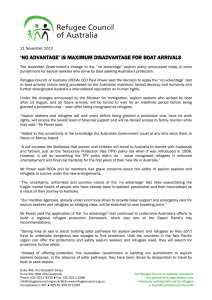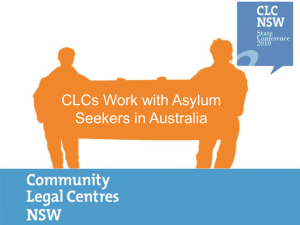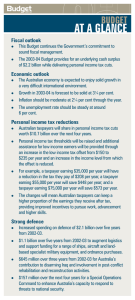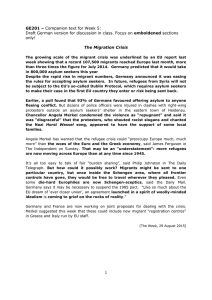Why Australians love to hate boat people
advertisement
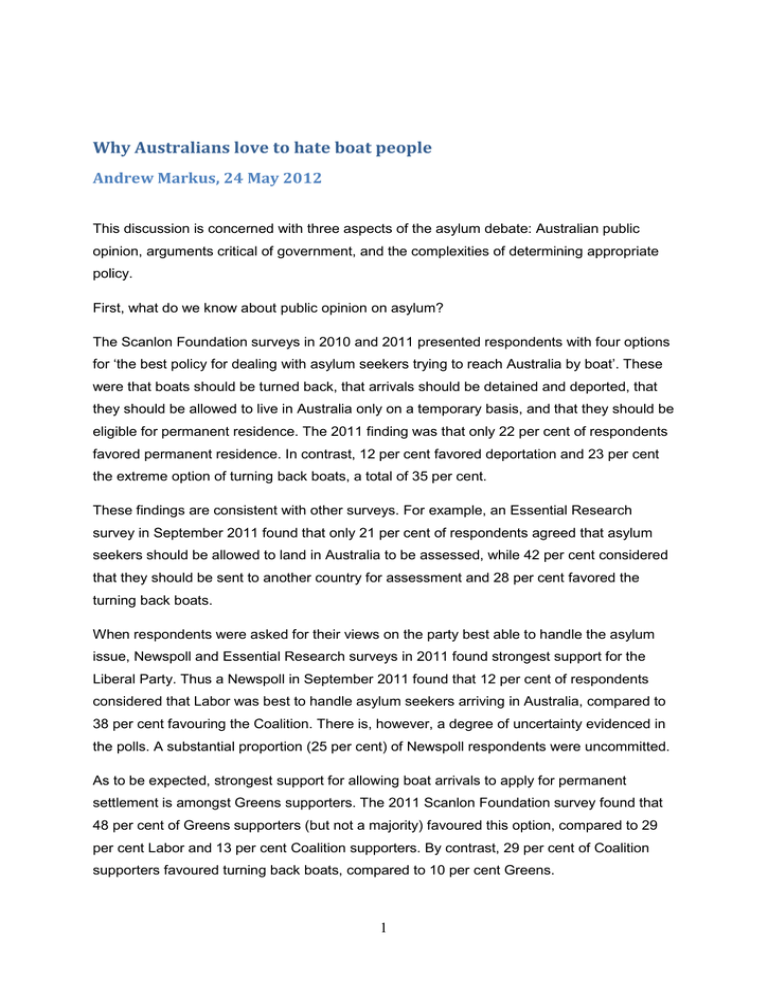
Why Australians love to hate boat people Andrew Markus, 24 May 2012 This discussion is concerned with three aspects of the asylum debate: Australian public opinion, arguments critical of government, and the complexities of determining appropriate policy. First, what do we know about public opinion on asylum? The Scanlon Foundation surveys in 2010 and 2011 presented respondents with four options for ‘the best policy for dealing with asylum seekers trying to reach Australia by boat’. These were that boats should be turned back, that arrivals should be detained and deported, that they should be allowed to live in Australia only on a temporary basis, and that they should be eligible for permanent residence. The 2011 finding was that only 22 per cent of respondents favored permanent residence. In contrast, 12 per cent favored deportation and 23 per cent the extreme option of turning back boats, a total of 35 per cent. These findings are consistent with other surveys. For example, an Essential Research survey in September 2011 found that only 21 per cent of respondents agreed that asylum seekers should be allowed to land in Australia to be assessed, while 42 per cent considered that they should be sent to another country for assessment and 28 per cent favored the turning back boats. When respondents were asked for their views on the party best able to handle the asylum issue, Newspoll and Essential Research surveys in 2011 found strongest support for the Liberal Party. Thus a Newspoll in September 2011 found that 12 per cent of respondents considered that Labor was best to handle asylum seekers arriving in Australia, compared to 38 per cent favouring the Coalition. There is, however, a degree of uncertainty evidenced in the polls. A substantial proportion (25 per cent) of Newspoll respondents were uncommitted. As to be expected, strongest support for allowing boat arrivals to apply for permanent settlement is amongst Greens supporters. The 2011 Scanlon Foundation survey found that 48 per cent of Greens supporters (but not a majority) favoured this option, compared to 29 per cent Labor and 13 per cent Coalition supporters. By contrast, 29 per cent of Coalition supporters favoured turning back boats, compared to 10 per cent Greens. 1 Thus, on face value, there is evidence to support the view that while Australians do not ‘hate boat people’ a large majority oppose granting permanent residence. Those who see widespread prejudice in Australian society explain it in terms of the nation’s history, tenor of public debate and the role of the media. Five types of arguments, premised on the influence of bigotry and racism in Australian society, are considered in the following discussion. First, there are arguments which focus on the legacy of the White Australia policy and Australian obsession with border control. The racially discriminatory White Australia Policy formed the basis for immigration policy until the 1970s and its influence is seen as continuing to the present day. Australia's obsession with border control is evidenced by the very small number of undocumented residents in the country, estimated to be less than 60,000 in 2010 (0.003 per cent of the population) - compared to the more than 11 million in the United States of America (0.35 per cent). Second, linked to arguments concerned with Australian national character is the evident need to demonize those asylum seekers who seek to reach Australia by boat. This was evident in the ‘children overboard affair’ in 2001, also in simplistic arguments that the asylum seekers are ‘queue jumpers’, that terrorists are obtaining entry into Australia on boats, or that the asylum seekers who manage to gain residence are living in luxury at the taxpayer’s expense. Even amongst those who eschew derogatory stereotyping, there is a refusal to face the desperate conditions of life that drive asylum seekers. This is evident in discussion by political leaders of the need to prevent asylum seekers risking their lives, ignoring the reality that lives are already at risk in refugee camps. An aversion of the gaze, a turning away, is also evident in the mantra that ‘we must destroy the people smuggler model’. Third is the evidence of bigotry evident in talk-back radio and the tabloid media. As has been argued by a number of commentators, there is grossly disproportionate emphasis given to boat arrivals, with attention to the daily tally of arrivals and the counting of boats and passengers since the dismantling of the Howard government’s ‘Pacific solution’. The record number of arrivals for a twelve month period is just under 8,000 (2011-12), a relatively small number in the context of Australian population movement, yet boat arrivals continue to receive far more attention than issues impacting on the lives of millions, such as education and health. 2 Fourth, evidence is presented to show that contrary to the outcry raised by the arrival of a relatively few asylum seekers, Australia fails to do its share to alleviate the world’s refugee problem. To take one of a number of possible examples, the Refugee Council of Australia has published tables comparing the role of countries in refugee protection. In the most recent consideration of eight criteria, Australia is shown as ranking first per capita for refugees resettled, but ranked from 17 to 69 on other criteria; thus, Australia is ranked 69 for refugees hosted; 48 for asylum applications pending; 35 for asylum applications received; 26 for refugees recognized, registered or resettled. (see http://www.refugeecouncil.org.au/r/statint.php) Fifth, it is argued that Australia’s policy for deterring boat arrivals resulted in gross abuse of human rights in the period of the Howard government – and the dishonourable policy continued in large measure under the Rudd and Gillard governments – yet the public seems concerned in large measure only with deterrence. The Howard government policies included turning back boats, with four boats carrying more than 600 people prevented from landing in 2001; locking up asylum seekers (including children) in detention centres located offshore and in remote regions of Australia; excising islands where refugees land from Australia’s immigration zone, with the consequence that asylum seekers arriving at such locations are barred from making a valid visa application; introduction of Temporary Protection Visas, so that those granted protection only gained temporary residence, and were separated from their families while they remained in Australia; and a punitive system (the Bridging Visa E regime) which left asylum seekers destitute if they appealed a failed refugee status determination. While changes were made to the policy in the last years of the Howard government, and further substantial reforms were undertaken under Labor, asylum seekers were still kept in mandatory detention for long periods while their claims were assessed; and asylum seekers and refugees continued to be, in effect, played off against each other, as each onshore protection grant led to a reduction of one place for refugee resettlement. Critics charge that the system of mandatory detention has done nothing to deter boat arrivals, being only effective in playing to the electorate at the risk of lifelong mental harm to detainees. John Menadue, a former Secretary of the Department of Immigration and Ethnic Affairs coauthored a policy paper which argued the case for the futility of mandatory detention. Summarising the argument, Menadue wrote in the Canberra Times (22 August 2011): 3 Our discussion on refugee reform is muddied by the myth that John Howard's tough policies after Tampa in 2001 worked. They didn't. When we analyse the asylumseeker flows to OECD nations in the years after 2001, the ebbs and flows to Australia largely match those to other OECD nations. It is likely that small differences in Australian numbers may have been caused by Howard policies, but it is obvious that the most significant factor in the number of asylum-seekers coming to Australia was the increase and decrease in global numbers. The numbers have varied as a result of wars in Iraq and Afghanistan, and the civil war in Sri Lanka. Howard's policies certainly affected boat numbers, but what is important is the total number of asylumseekers. If one mode of arrival becomes more difficult, asylum-seekers will try another mode… UNHCR reports that asylum numbers to Australia increased from 2004 to 2010. The numbers were increasing in the last three years of the Howard government. Criticism of Australian policy is thus made with force and emotion, but it is open to challenge. It often reduces complex issues to a one dimensional perspective. First, the charge of Australian bigotry and racism. One immediate problem is that while there is evidence of strong negative feeling towards boat arrivals, support for the humanitarian program, which selects victims of persecution in refugee camps for resettlement in Australia, has been maintained at a high level. The Scanlon Foundation survey registered support at 67 per cent in 2010 and a higher 73 per cent in 2011. Second, Australia has a significant record for admission of refugees for permanent residence. Since 1945, over 700,000 refugees and displaced persons have been resettled; in the ten years to 2006-07, during the period of the Howard government, a total of 126,195 humanitarian visas were granted. On the basis of its relatively small population, Australia leads the world for refugee resettlement, as Professor Graeme Hugo indicated in a recent publication. 4 Source: G. Hugo, ‘Economic, Social and Civic Contributions of First and Second Generation Humanitarian Entrants’, Final Report to Department of Immigration and Citizenship, May 2011, p. 2 Statistics used by critics of government policy have some significant flaws. Australia is compared with regions and countries with much larger populations and economies – as in comparison of asylum seekers reaching Australia and Europe, or Australia and the United States. Other comparisons are with third world countries, such as Pakistan and Iran, which receive large numbers of cross-border arrivals – and house the asylum seekers in camps funded by the United Nations High Commissioner for Refugees. These camps provide little or no prospect for resettlement and the building of new lives; they bear no resemblance to resettlement in Australia. There is also a flaw in the way that United Nations data has been used, in the failure to compare like with like. Recent UNHCR data indicates that in the ten years to 2009 Australia hosted 22,548 people who reached the country as asylum seekers – this is the basis for ranking Australia as 48 or 69 in global comparisons. But Australia makes its major contribution to alleviation of the international refugee problem not as a country of reception for asylum seekers, but through refugee resettlement. If the number of asylum seekers reaching Australia and refugees resettled is combined, the total reaches over 130,000 for the ten years to 2010. When this total is compared with the contribution of developed countries on the basis of population size, Australia is ranked within the top five; on my count it comes 5 third, after Sweden and Germany, and ahead of the United Kingdom, France, the United States of America and New Zealand. The third complexity is the argument that deterrence does not work. As noted, John Menadue has argued that it is a myth that ‘Howard’s tough policies … worked. They didn’t.’ But he also observed that ‘Howard’s policies certainly affected boat numbers, but what is important is the total number of asylum-seekers’. This is a very confused argument. The sole aim of the Howard polices was to ‘affect boat numbers’. The Howard government did not seek to put an end to the humanitarian program, nor were arrivals by plane a political problem. Its policy achieved its goal, to stop the movement to Australia by boat; arrivals numbered 4,137 in 2000-01, 3,039 in 2001-02, and 301 over the following six years: nil in 2002-03, followed by annual totals of 82, nil, 61, 133 and 25. The fourth complexity relates to balance. As noted, it is argued that Australia does not do its share, but how is its share to be determined? Australia could certainly do more – over the last 25 years its humanitarian intake has been largely held constant as the population has grown, so the number resettled relative to population has declined. Advocates argue for an increase to 20,000 annually, but this is not the total envisaged, for it is also argued that boat arrivals should be in a separate category to the places allocated in the humanitarian program, and that the admission of boat arrivals be uncapped. This raises the question which has not received realistic consideration: at what point does the number of uncapped arrivals become unsustainable, given that Australia maintains a high cost resettlement program. It is argued that there are only a few thousand boat arrivals a year, so there is no problem. But an open pathway to permanent residence in Australia has the potential to significantly increase the flow. This is an issue to be considered in the context of refugee and ‘refugee like’ populations in the Asia region, which in 2010 totalled 1.9 million in Pakistan, 1.07 million in Iraq, and 230,000 in Bangladesh. Population flows are dynamic, not static. Australian policy is able to exercise a determining influence on these flows to Australia, as demonstrated by the pattern of boat arrivals since 2000. The challenge for government is the determination of the appropriate humanitarian and financial balance. The current cost of dealing with boat arrivals is difficult to establish, in part because costs are taken from a number of department budgets, but there are estimates of the order of $2 billion annually. We know from budget papers that the cost of community and detention services increased from $35.2 million in 2008-09 to a projected $709.4 million in 2011-12. Associated departmental expenses over the same period increased from $59.2 million to 6 $233.3 million. There are also costs numbering hundreds of millions in combating people smuggling. The 2010-11 budget allocated $1.2 billion to ‘bolster Australia’s border security’. If asylum seekers are released from detention there are major cost savings, but substantial housing costs remain in the initial period of refugee settlement, in addition to other forms of assistance. Many refugees find it very difficult to obtain jobs in a labour market that is increasingly geared to skilled occupations and which requires high levels of English language competence. Analysis of labour force status in 2006 of those who arrived over the previous five years indicates that 67 per cent of skilled entrants were working full or parttime, compared to 27.1 per cent of refugees. (Hugo, ‘Humanitarian Entrants’, p. 124) Limited funding and competing needs are illustrated using two examples. First, foreign aid. The United Nations indicates that there are more than one billion people living in extreme poverty; it estimates that 22,000 children under the age of five die from starvation and preventable diseases every day. Australia’s foreign aid budget for 2012-13 is $5.15 billion, with 70 per cent allocated to Asia and the Pacific. The planned level of funding for 2012-13 has been reduced because of financial pressures. Of funding provided, 19 per cent is to be allocated to saving lives, 26 per cent to fostering sustainable economic development, and10 per cent to humanitarian aid. Australian funding over the next four years is designed to help 4 million children from poor families to enrol in school, vaccinate more than 10 million children, and provide over 2 million poor with access to financial services. The total allocated for Australia’s work with six UN agencies - UNICEF, UN Women, the UN Development Program, World Health Organisation, UN Population fund and UN AIDS – is $154 million over four years. The allocation to the United Nations High Commissioner for Refugees (UNHCR) is only $19 million and the International Committee of the Red Cross $22 million. With regard to poverty in Australia, research commissioned by ACOSS (the Australian Council of Social Service) and conducted by the Social Policy Centre at the University of New South Wales, estimated that in 2006, 2.2 million Australians (11.1 per cent of the population) were living in poverty. These figures were obtained using a conservative measure, less than 50 per cent of the median income. Using the figure currently used by the European Union, which is set at less than 60 per cent of median income, the number of Australians living in poverty rises to 3.8 million (19.4 per cent of the population). 7 There is a tendency for advocacy groups to ignore the difficult choices that governments must make. Part of the problem evident in Australian debates over asylum is the certitude and arrogance of the ‘true believers’, on all sides of politics. The need is for the issue to be approached with empathy and compassion, but also balanced consideration of rival demands on limited resources – and a realistic appraisal of the impact of changes in government policy on asylum flows. 8
